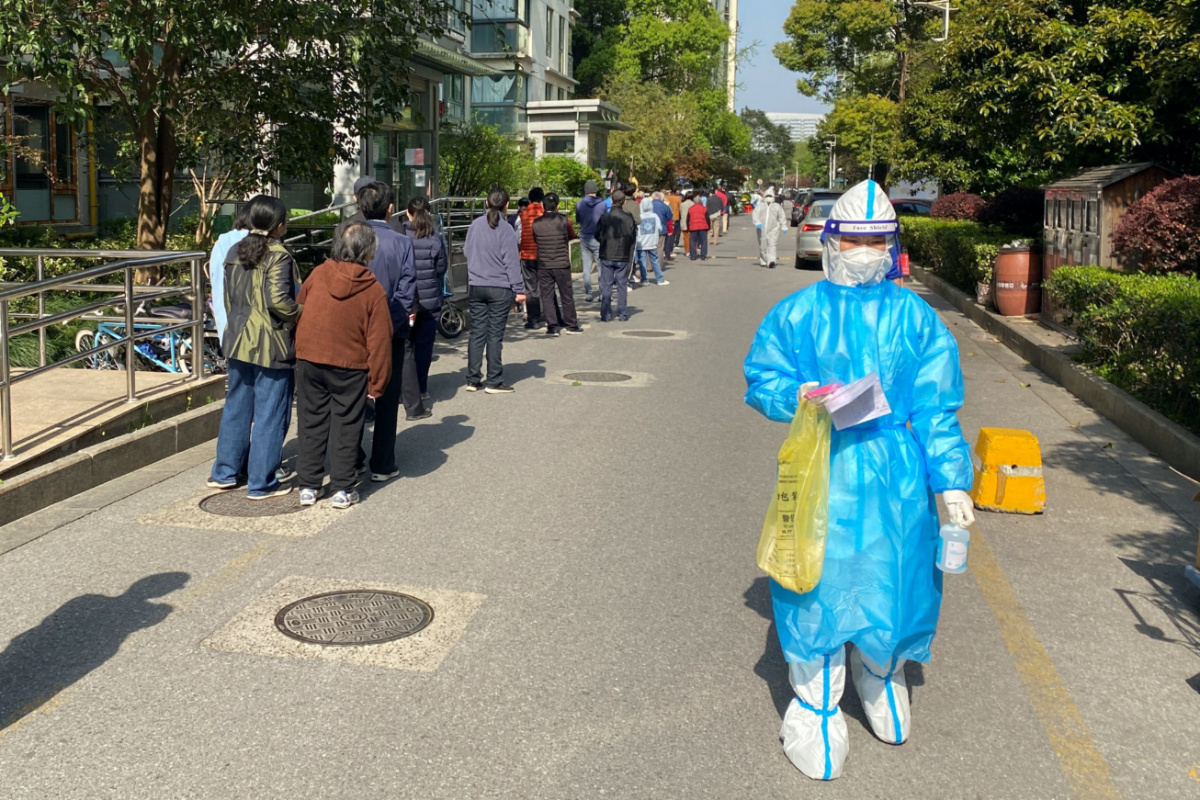Shanghai, China
Reuters
Shanghai on Friday announced a record 21,000 new cases and a third consecutive day of COVID testing as a lockdown of its 26 million people showed no sign of easing and other Chinese cities tightened curbs – even in places with no recent infections.
Beijing authorities intervened in Shanghai after its failure to isolate COVID by locking the city down in stages, and insists that the country stick to its zero-tolerance policy to prevent its medical system from breaking down.

A medical worker in a protective suit walks past a line of people waiting to take nucleic acid test at a locked down residential area, following the coronavirus disease (COVID-19) outbreak in Shanghai, China, on 7th April. PICTURE: Reuters/David Stanway.
Authorities across China, which have mostly managed to keep COVID at bay for the last two years, are stepping up coronavirus control measures, including movement restrictions, mass testing and new quarantine centres.
Cities that sprang into action this week include Zhengzhou, in central Henan province, which on Thursday said it would test all 12.6 million residents after finding a few asymptomatic cases.
Beijing has strengthened regular screening for employees in the city’s key sectors, requiring all staff at elderly care agencies, schools and institutions handling imported goods to take tests at least once a week.
In Shizong county in southwest China’s Yunnan province, shops were shut, transport suspended and residents barred from leaving their towns or villages.
Nomura this week estimated that 23 Chinese cities have implemented either full or partial lockdowns. The cities collectively are home to an estimated 193 million people and contribute 22 per cent of China’s GDP. These include Changchun, a major manufacturing hub that has been locked down for 28 days.
Ernan Cui, an analyst at Gavekal Dragonomics who studied COVID policies announced by China’s 100 largest cities, said most were choosing to keep restrictions in place even after case numbers returned to zero.
The curbs “suggest that the economic impact of the various lockdowns will not ease in a matter of days or even weeks”, she said in a note.
If Shanghai’s lockdown continues throughout April the city will suffer a six per cent loss in GDP, amounting to a two per cent GDP loss for China as a whole, ING Chief Economist for Greater China Iris Pang said in a note.
White House press secretary Jen Psaki said in a briefing on Friday that the Biden administration was closely monitoring the lockdown in Shanghai, noting that it could cause delays for air cargo.
“Thunderous action”
Shanghai’s outbreak has surpassed 130,000 cases in total, far exceeding the approximately 50,000 symptomatic cases recorded in the original outbreak in the central city of Wuhan, where the virus was first detected in late 2019, although Chinese authorities did not start reporting asymptomatic cases until after Wuhan’s peak.
Stories of crowded and unsanitary central quarantine centres and fears of family separation have driven calls for home quarantine in Shanghai.
The Shanghai government has started allowing some close contacts to isolate at home and on Wednesday eased its policy of separating infected children from their parents.
However, food supply remains a concern with residents, due to a shortage of couriers.
We rely on our readers to fund Sight's work - become a financial supporter today!
For more information, head to our Subscriber's page.
On Friday afternoon results for hashtag “Shanghai buy food” were blocked on the Twitter-like social media site Weibo.
Weibo did not immediately respond to a request for comment.
Shanghai has not indicated when it may lift its lockdown.
Late on Thursday, Wu Zunyou, chief epidemiologist at the China Center for Disease Control and Prevention, said on its Weibo account that action taken in Shanghai had to be “thunderous” to cut off the chain of transmission.
In theory, he said, if multiple rounds of PCR testing were conducted in mega-cities with populations as large as 27 million within two to three days, they could reach zero cases “on the community level” within 10 days to two weeks.
Of Shanghai’s cases, just one is suffering severe symptoms and is under treatment, a health official said on Friday.
– With the Beijing newsroom.






